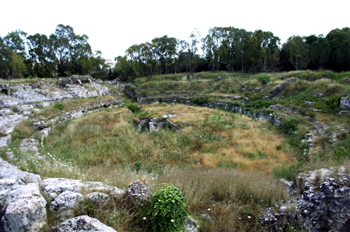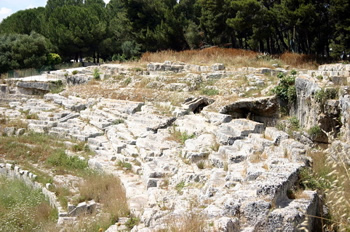 |
| The arena of the Roman Amphitheater of Syracuse. |
The Roman Amphitheater in Syracuse.
The amphitheater built in Syracuse during
the Roman period (it was probably started during the reign of Nero,
but took the form we see today only in the 3rd-4th century A.D.) is the
largest (measuring 140 meters by 119 / 460 feet by 390) in Sicily, and
one of the largest in Italy (being slightly smaller than the Arena
of Verona).
 |
| The arena of the Roman Amphitheater of Syracuse. |
The structure was used for gladiator and animal fights, while the nearby theater was reserved for proper theatrical presentations.
Today, only the portion of the Amphitheater
carved into the rock remains, while all that was built of stone blocks
was dismantled by the Spanish
in the 16th century to build fortifications of the island of Ortigia.
The centuries have also been carved into
the rock, which now shows veins running diagonally across the rows of seats.
Because of the bad quality of its original stone, the amphitheater was
entirely recovered with stone blocks, and these were also dismantled by
the Spanish.
At the center of the arena a rectangular
excavation (covered, in ancient times) contained equipment used for performances.
Despite its material damage, the building
retains by virtue of its size an aura of majesty and grandeur.
 |
| The seats of the Roman Amphitheater of Syracuse, carved directly into the rock of which the centuries have highlighted the veins, which here are very visible. |
Within the Roman Amphitheater of Syracuse, visitors can only walk along the top ring (with the exception of the stairs and the arena); in compensation, the route is facilitated by a convenient flat road, which runs from one end of the structure to the other.
Surrounding the amphitheater and on the access road one can see several ancient sarcophagi, transported here from the necropolis in the area, as well as some remains of houses dating from the Hellenistic period.
How to Reach the Roman Amphitheater
from the Algilà
Ortigia Charme Hotel.
The Roman Amphitheater of Syracuse is
part of the Archaeological
Park, which is located off the island of Ortigia
and more precisely at the extreme north of the ancient city (Neapolis).
A route by foot is possible, but it will exceed one kilometer
/ 0.62 miles in distance.
Those who do not have their own transportation
can call a taxi from the reception desk at a special rate or use the bicycles
that the Hotel Algilà offers to its guests for free.
Alternatively, one can take the (free)
shuttle bus #20 from the nearby Piazza
Archimede up to the bus station (near the train station) and
then take either one of the following bus lines: 6, 8, 11, 12 or
13.
Otherwise, from Riva Nazario Sauro (behind
the nearby Piazza delle Poste) one can choose from the following bus lines
1, 2, 3, 4 or 12.
Visitor Information.
All of the sights within the Archaeological
Park can be visited with a single ticket of entry (full price € 6, with
reduced-priced tickets available for those aged 18 to 25 years and free
entry for citizens of the European Union under 18 or over 65). Remember
not to throw away the ticket to go from one area to another.
Admission is free for people with disabilities
and for those who accompany them.
Unfortunately, the chronic shortage of
staff requires the closing in turn of some parts of the archaeological
area, depending on the day (one can ask about the situation at the ticket
office prior to entering). The partial closure of the area does not result
in discounts on the cost of the ticket.
The park is open every day, including
holidays, from 9:00 a.m. until two hours before sunset.
Because of the enormous quantity of sights worth visiting in the Archeological Park and the extensive size of the area, one should plan to spend at least an hour and a half for a leisurely visit.
The area is organized in such a way as to be accessible from a convenient road, which is easy to follow even for those who have difficulty walking (here a "problem" may arise only because of the extensive size of the area itself).
Back to TOURISM IN SYRACUSE, SICILY